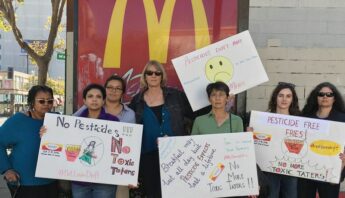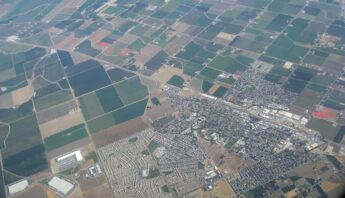For Immediate Release: August 27, 2014
Contacts: Paul Towers, PAN, 916-216-1082, ptowers@panna.org
Children’s Health Advocates Push for Better Protections from Pesticides as Children Head Back to School
25,000+ call on state leaders to start by phasing out the use of brain-harming pesticide chlorpyrifos
Sacramento, CA– As children across California return to school, parents, teachers and health professionals are calling on the California Department of Pesticide Regulation (DPR) to make protecting children’s health a priority, starting with phasing out use of the brain-harming pesticide chlorpyrifos. A growing body of evidence points to impacts on children’s health and learning from a wide range of pesticide exposures in the air, food, and water.
“California officials need to start the school year off right by pledging their commitment to protecting children’s health from hazardous pesticides,” said Tracey Brieger, co-director of Californians for Pesticide Reform, a coalition representing 185 groups. “DPR is failing our children and undermining their potential if they don’t move swiftly to dramatically reduce use of the most hazardous and volatile chemicals. Officials owe California parents a comprehensive plan for how they plan to phase out the most hazardous pesticides.”
Evidence released at the close of last school year and over the summer underscores what advocates have been saying for years: a strong and growing body of evidence links pesticides to harmful impacts on children’s health and intelligence. Since last spring, several pieces of new information have come to light, including:
- In the top 15 agricultural counties, more than 500,000 schoolchildren spend their day in close proximity to hazardous pesticide use.
- Publically accessible USDA data compiled through WhatsOnMyFood.org shows that foods commonly consumed by children — especially apples and peaches — are more likely to contain residues from brain-harming chlorpyrifos.
- A study from the UC Davis MIND Institute found that mothers who live within a mile of fields where hazardous pesticides are applied are 60% more likely to have children with autism.
In just the past few years, the American Academy of Pediatrics and American Congress of Obstetricians and Gynecologists reviewed the scientific literature and issued a new call for policymakers to protect children from hazardous pesticides.
“The weight of the evidence is in, and California officials charged with protecting children’s health must take action now,” said Harry Wang, MD, child psychiatrist and vice-president of Physicians for Social Responsibility–Sacramento. “Their developing bodies make children especially vulnerable to the impacts of pesticides.”
With hundreds of different hazardous pesticides applied near schools, near homes and on the food children eat, children face many sources of exposure throughout the day and over the course of their life.
On Tuesday, a group of teachers’ unions in the Monterey Bay Area voiced their concerns around recent findings of pesticide applications near schools, following up on a letter they sent in June. Two of the top three schools with the most hazardous pesticides used nearby are located in this central coast region. “Schoolchildren and their teachers are bearing the brunt of pesticides in and around schools,” said Cesar Lara, executive director of the Monterey Central Labor Council, speaking on behalf of teachers’ union affiliates.
One pesticide has increasingly come into the spotlight in recent months. Over one million pounds of chlorpyrifos are used across the state each year, most commonly on nuts, citrus and alfalfa. A decade after the pesticide was banned for use in homes, California is poised to take further action on chlorpyrifos. At their first public meeting earlier this month, DPR officials declared that they plan to make chlorpyrifos a “restricted material,” potentially limiting some applications near schools by June 2015. But agency officials have yet to articulate a plan for phasing the chemical out — or for adopting the additional protections that children’s health advocates say should be implemented immediately.
To underscore their point, advocates delivered more than 25,000 petitions and letters to DPR director Brian Leahy today, collected by food, farmworker, farming and environmental health groups, including Center for Environmental Health, Food and Water Watch, Pesticide Action Network, TakePart and United Farm Workers.
“Chlorpyrifos illustrates the current regulatory system's failure to protect children’s health,” said Anne Katten, MPH, pesticide and work safety project director at California Rural Legal Assistance Foundation. “After more than a decade of review, there is now a preponderance of scientific evidence of harm, as well as documented impacts in California communities, and state officials are still dragging their feet. DPR must move quickly to finish its assessment, adopt better protections, and help farmers transition to safer cutting-edge alternatives as they finally phase out this dangerous chemical.”
Advocates also say phasing out one chemical is a good start, but not nearly enough to adequately protect children’s health and learning potential. “California officials can’t take a whack-a-mole approach to pesticides,” said Kristin Schafer, policy director at Pesticide Action Network. “They must find ways to comprehensively reduce exposure to hazardous pesticides, starting with the communities most impacted.”
###







